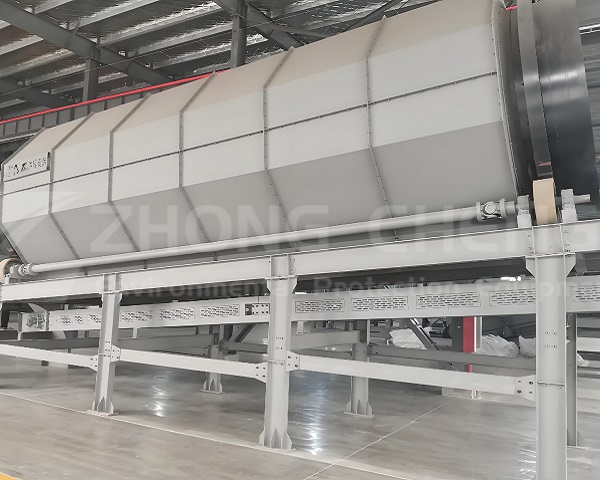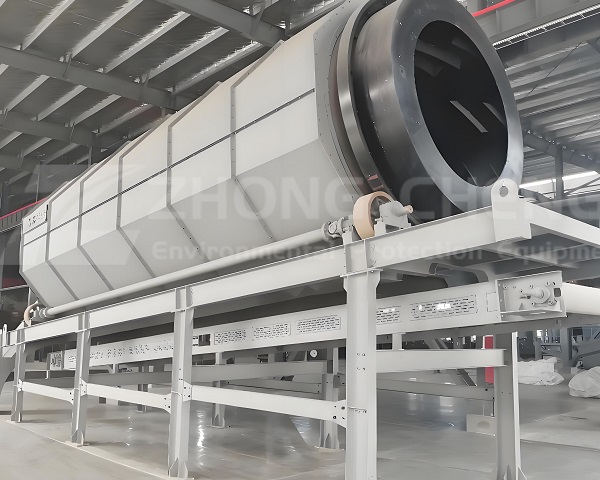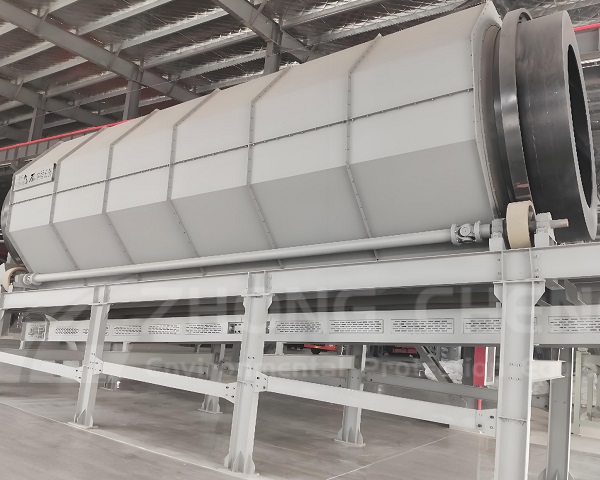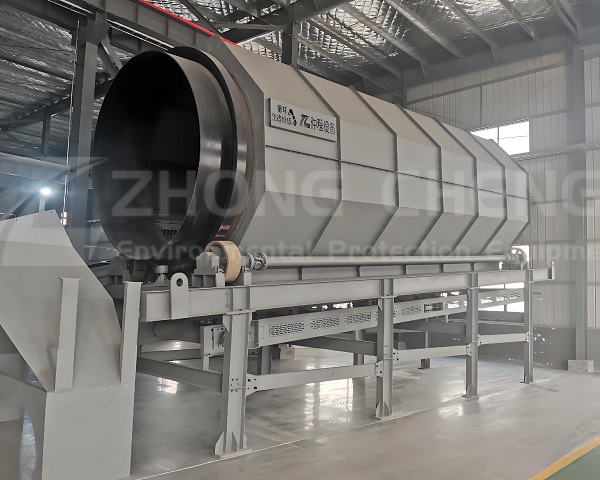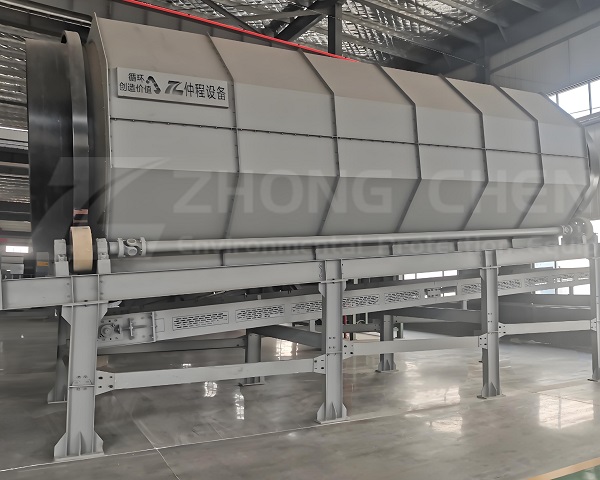A Trommel Screen is a rotary drum screening machine widely used in waste processing, mining, and construction industries. It efficiently separates materials by ......
What is the Rotary Drum Screen
The rotary drum screen is a key screening equipment widely used in many industries. With its unique working principle and excellent performance, it plays an important role in the field of material handling.
From a structural point of view, the rotary drum screen is mainly composed of a drum, a drive device, a frame, an inlet and outlet, and a cleaning device. The drum is the core component, usually composed of screens of different specifications, and its inclination angle and speed can be adjusted according to actual needs. The drive device provides power for the rotation of the drum to ensure the stable operation of the equipment; the frame plays a supporting and fixing role; the inlet and outlet are responsible for the entry of materials and the discharge of materials after screening; the cleaning device can effectively prevent the sieve holes from being blocked and ensure the screening efficiency.
Its working principle is based on the movement and screening of materials in the drum. When the material enters the drum from the feed port, as the drum rotates, the material rolls and slides along the inner wall of the drum under the dual effects of centrifugal force and its own gravity. In this process, fine particles smaller than the size of the sieve hole fall through the screen to achieve material grading and screening; while particles larger than the size of the sieve hole continue to move forward and are eventually discharged from the discharge port at the other end, completing the entire screening process.
The rotary drum screen has many significant advantages. First, it has high screening efficiency and can process a large amount of material in a short time to meet the needs of large-scale production. Secondly, it has a wide range of applications and can handle materials of various properties, such as granular, block, flake, etc. Whether it is dry or wet materials, it can achieve effective screening. Furthermore, the equipment has a simple structure, stable and reliable operation, and convenient maintenance, which reduces the cost of use.
In terms of application areas, the rotary drum screen has outstanding performance in mining, building materials, chemicals, grain processing and other industries. In the mining industry, it is used for grading and impurity removal of ores; in the field of building materials, it is used to screen sand and gravel aggregates; in the chemical industry, it is used to process chemical raw materials; in grain processing, it can screen and grade grains to remove impurities
The rotary drum screen has become a powerful assistant in the field of material screening with its excellent performance and wide applicability.
Operating principle of Rotary Drum Screen
The rotary drum screen is an efficient material screening equipment. Its working principle is based on the movement and screening of materials in the rotating drum, which can effectively separate materials of different particle sizes.
1. Material entry and initial movement
When the material is fed into the rotary drum screen from the feed port, the screening journey begins. At this time, the drum begins to rotate driven by the drive device. Due to the certain inclination angle of the drum, the material will move slowly along the axis of the drum under the action of gravity. At the same time, the rotation of the drum causes the material to be subjected to the centrifugal force and begin to roll and slide on the inner wall of the drum. This is like an inclined and rotating slide. The material moves downward while constantly changing its position under the push of centrifugal force.
2. Screening process
The drum is usually composed of screens of different specifications, and the size of the screen holes is designed according to the screening requirements of the material. During the rolling and sliding of the material, fine particles smaller than the size of the screen holes, like a group of flexible elves, can easily pass through the screen and be discharged from the under-screen part of the drum to complete the initial screening. Particles larger than the size of the sieve hole are like being blocked by a series of "checkpoints". They continue to move forward with the rotation of the drum and cannot pass through the screen.
3. Anti-blocking mechanism
During the screening process, some fine particles or impurities in the material may get stuck in the sieve hole, causing the sieve hole to be blocked and affecting the screening efficiency. In order to solve this problem, the rotary drum screen is equipped with a cleaning device. The cleaning device can be in various forms, such as a brush, an elastic ball, etc. When the drum rotates, the cleaning device will continuously contact the screen to clean out the particles stuck in the sieve hole, ensuring the smooth flow of the sieve hole, so that the screening process can be carried out continuously and efficiently.
4. Material discharge
After screening, fine particles that meet the particle size requirements are discharged from the bottom of the screen, while large particles larger than the size of the sieve hole are discharged from the discharge port at the other end of the drum, thereby realizing the separation of materials of different particle sizes. By adjusting the parameters such as the speed of the drum, the inclination angle, and the specifications of the screen, the screening requirements of different materials can be met.
Advantages and features of Rotary Drum Screen
As a common screening equipment, the rotary drum screen plays an important role in many industries and has the following significant features and advantages:
A. Features of the rotary drum screen
1. Simple and reasonable structure
The rotary drum screen has a compact overall structure and is mainly composed of drums, drive devices, frames and other components. The drum is made of high-quality steel and is sturdy and durable; the drive device operates stably and can provide reliable power for the rotation of the drum. This simple structural design not only reduces the manufacturing cost of the equipment, but also facilitates the installation, commissioning and maintenance of the equipment.
2. Wide screening range
The screen specifications can be flexibly replaced according to actual needs, and can adapt to the screening requirements of materials of different particle sizes. Whether it is ore, sand and gravel with larger particles, or chemical raw materials, grains with fine particles, etc., they can be effectively screened to meet diverse production needs.
3. Smooth and reliable operation
During the rotation process, the drum runs smoothly with low vibration and noise due to the use of advanced balance design and stable drive system. This not only increases the service life of the equipment, but also improves the working environment and reduces the impact on the health of operators.
A. Advantages of rotary drum screen
1. High screening efficiency
The unique screening method of rotary drum screen enables the material to fully roll and disperse in the drum and fully contact with the screen, thereby greatly improving the screening efficiency. Compared with traditional screening equipment, it can process more materials in a shorter time and improve production efficiency.
2. High screening accuracy
By reasonably selecting the screen specifications and adjusting the equipment parameters, the rotary drum screen can achieve high-precision screening, accurately separate materials of different particle sizes, and ensure the quality stability of the product.
3. Strong adaptability
The equipment has strong adaptability to the humidity, viscosity and other characteristics of the material. Even if the material contains a certain amount of moisture or sticky substances, it can be screened normally. At the same time, it can also adapt to different working environments and working conditions, and has strong versatility.
4. Low maintenance cost
The rotary drum screen has a simple structure, few parts and a low failure rate. Moreover, its wearing parts are easy to replace, and the maintenance cost is relatively low, which can save a lot of operating costs for the enterprise.
Technical Parameter Table of Rotary Drum Screen
| Parameter name | Parameter value (model A) | Parameter value (model B) | Parameter value (model C) | Parameter value (model D) | Parameter value (model E) | Remarks |
|---|---|---|---|---|---|---|
| Drum diameter (mm) | 1200 | 1500 | 1800 | 2000 | 2200 | Select according to processing volume requirements |
| Drum length (mm) | 3000 | 4000 | 5000 | 6000 | 7000 | Length affects screening efficiency and output |
| Sieve size (mm) | 5, 10, 15, 20 | 5, 10, 20, 25 | 10, 15, 20, 30 | 15, 20, 25, 35 | 20, 25, 30, 40 | Can be customized according to material characteristics |
| Speed (r/min) | 15-25 | 12-20 | 10-18 | 8-15 | 6-12 | Speed affects screening efficiency and material passing rate |
| Power (kW) | 5.5 | 7.5 | 11 | 15 | 18.5 | Power is related to drum size and speed |
| Processing capacity (t/h) | 10-30 | 20-50 | 30-80 | 50-120 | 80-180 | The processing volume is affected by the screen size, rotation speed and material characteristics |
| Tilt angle (°) | 5-10 | 5-10 | 5-10 | 5-10 | 5-10 | The tilt angle affects the residence time of the material in the drum and the screening efficiency |
| Material | Carbon steel | Stainless steel | Carbon steel + wear-resistant coating | Stainless steel + wear-resistant lining | Special alloy | Select according to material characteristics and use environment |
| Drive mode | Motor + reducer | Motor + reducer | Motor + reducer | Motor + reducer | Motor + reducer | Ensure stable and reliable drive |
| Noise level (dB) | ≤75 | ≤75 | ≤75 | ≤75 | ≤75 | Meet industry environmental protection standards |
| Weight (kg) | 2000 | 3500 | 5000 | 7000 | 9000 | Weight varies with drum size and material |
If you have any special requirements, we will customize according to your special needs.
Product Picture Display of Rotary Drum Screen
FAQ about Rotary Drum Screen
>What types of materials are suitable for rotary drum screens?
Rotary drum screens are suitable for processing a variety of materials, including ores in the mining industry (such as iron ore, copper ore and other ores of different particle sizes), sand and gravel aggregates in the building materials field (including river sand, machine-made sand and other types of sand and gravel), chemical raw materials in the chemical industry (such as granular or block plastic particles, fertilizer raw materials, etc.), grains in grain processing (such as wheat, corn, etc., which can remove impurities and grade) and granular, block and flaky materials in other industries. Whether dry or wet materials, they have certain applicability.
>How to choose the mesh specifications of rotary drum screens?
When selecting the mesh specifications of rotary drum screens, it is necessary to base on the material characteristics and screening requirements. According to the particle size distribution of the material, determine the target screening particle size, and select the mesh size based on this; if the material contains more fine particles that need to be separated, select a small mesh screen; when the processing volume is large and the fine particle size requirement is not high, a large mesh screen can be selected. At the same time, considering the hardness of the material, wear-resistant material screens are selected for hard materials, and the selection range of soft materials can be slightly wider.
>What factors affect the output of rotary drum screen?
The output of rotary drum screen is affected by many factors. In terms of drum specifications, the larger the diameter and length, the larger the material capacity and screening space, and the higher the output; the rotation speed affects the speed of material movement in the drum. Reasonable rotation speed can speed up screening, and too high or too low speed is not conducive to output; in material characteristics, materials with high humidity and strong viscosity are easy to block the screen holes, reduce screening efficiency, and affect output; the screen specifications are also critical. The larger the screen holes, the faster the material passes, and the output may increase, but it will affect the screening accuracy.
>What should I do if the rotary drum screen is blocked during operation?
When the rotary drum screen is blocked during operation, stop the machine first to check the location and cause of the blockage. If it is caused by high humidity and strong viscosity of the material, the moisture content of the material can be adjusted, and the material can be dried or anti-sticking agent can be added before entering. If the screen is damaged or improperly installed, replace or reinstall the screen in time. If the cleaning device fails, check and repair the cleaning device, such as replacing worn brushes, repairing the elastic ball movement mechanism, etc., to ensure its normal operation to prevent blockage again.
>What are the key points of maintenance of rotary drum screen?
The key point of maintenance of rotary drum screen is to regularly check the drum, screen and transmission parts. Check whether the drum is deformed or worn, and repair or replace it in time if problems are found; check whether the screen is damaged or blocked, and clean or replace it in time; for transmission parts such as motors and reducers, regularly check the lubrication, add or replace lubricating oil, tighten loose bolts, ensure the normal operation of each component, and extend the service life of the equipment.
>What is the effect of the inclination angle of the rotary drum screen on the screening effect?
The inclination angle of the rotary drum screen has a significant impact on the screening effect. When the angle is small, the material stays in the drum for a long time, the screening is more complete, but the output will be reduced, which is suitable for situations with high requirements for screening accuracy and small processing volume; when the angle is large, the material slides down quickly, the output is increased, but the screening time is short, which may affect the screening accuracy. It is suitable for scenes with large processing volume and low requirements for screening accuracy. The inclination angle needs to be reasonably adjusted according to actual needs.
>How to judge whether the driving device of the rotary drum screen is normal?
There are many aspects to judge whether the driving device of the rotary drum screen is normal. Listen to the sound. During normal operation, the sound is stable and without noise. If there is an abnormal sound, there may be a fault. Measure the temperature. Touch the outer shell of the motor, reducer and other components with your hand. The temperature should be within the normal range. Overheating may indicate excessive load or poor lubrication. Check the speed. Check whether the drum speed meets the set value. Abnormal speed may be a drive system failure. Check the vibration. The equipment should run smoothly without obvious vibration. Excessive vibration may affect the performance of the drive device.
> What are the precautions for installing the rotary drum screen?
When installing the rotary drum screen, ensure that the installation foundation is flat and solid, and can withstand the vibration and weight of the equipment during operation. The installation location should be convenient for material entry and exit and equipment maintenance, leaving enough operating space. The drum should be installed horizontally and the inclination angle should meet the design requirements to ensure normal flow and screening of materials. The transmission components should be installed accurately, and the components should be firmly connected to avoid looseness. After the installation is completed, debug and check whether the equipment runs smoothly and without abnormalities.
> What is the energy consumption of the rotary drum screen?
The energy consumption of the rotary drum screen is affected by many factors. In terms of equipment specifications, large equipment has high power and relatively high energy consumption; the higher the speed, the more work the motor does, and the energy consumption increases; in terms of material characteristics, materials with large processing volume and strong viscosity have large equipment operation resistance and high energy consumption. However, by reasonably selecting equipment specifications, optimizing speed, controlling material processing volume and other measures, energy consumption can be effectively reduced and energy utilization efficiency can be improved.
>What are the advantages and disadvantages of rotary drum screens compared with vibrating screens?
The advantages of rotary drum screens are simple structure, stable operation, low noise, strong adaptability to material humidity and viscosity, and low maintenance cost; the disadvantages are that the screening accuracy is slightly lower than that of vibrating screens and the floor space is large. The advantages of vibrating screens are high screening accuracy, large processing volume, and small floor space; the disadvantages are complex structure, large vibration and high noise during operation, and they are sensitive to material humidity and viscosity. Materials with high humidity or strong viscosity are easy to clog the screen, and the maintenance cost is relatively high.


























